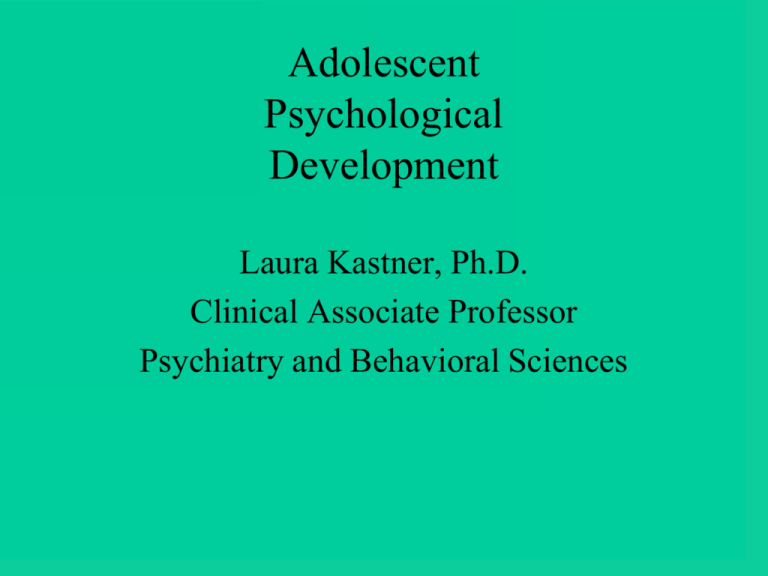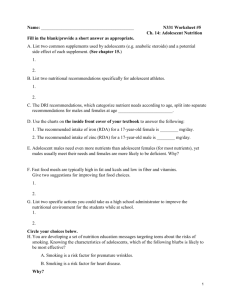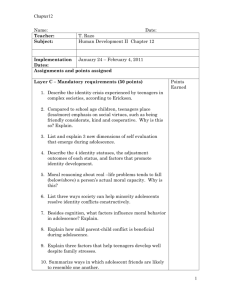Adolescent Psychological Development
advertisement

Adolescent Psychological Development Laura Kastner, Ph.D. Clinical Associate Professor Psychiatry and Behavioral Sciences Why is it important for a adolescent health clinicians to know the basics about adolescent development? • They are frequently asked the question by parents, “Is this normal or a sign of pathology?” (e.g. moodiness, withdrawal, rebelliousness, defiance, irrationality, argumentativeness) • They can be faced with teen emotions while interviewing adolescent patients that impede diagnosis and treatment. Why is it important for a clinicians to know the basics about adolescent development? They may experience personal reactions that hinder effective medical transactions if they don’t understand the dynamics of adolescent development. “My 15 year old son… “ My 15 year old son, Randy, is rude, won’t talk at dinner, wants to just hang out in his room, won’t share any information with us, cares more about his electronics than anything, becomes irrational when we confront him, hogs the bathroom, is highly emotionally reactive, and has lied, snuck out and drank alcohol at a party and violated our internet rules.” “A website on drug abuse cited these warning signs: • withdrawal • moodiness • increased family conflict • argumentativeness • over-reactivity to criticism • sloppiness in appearance • spending time isolating in room • poor attitude • disrespect • loss of interest in family activities.” “Does my son have a drug abuse problem?” Adolescent Psychological Development • • • • • Physical development Cognitive development Social development Identity development Moral development Physical development • Pubertal development • Bodily changes resulting in increased selfconsciousness, preoccupation and questions of “Am I normal?’ • Alterations in sleep (and less!) • Sexual interests and changes in social responses • Sexual identity development Cognitive Development (historical review) • Shift from concrete to formal operations, allowing for greater abstract thinking skills, symbolic reasoning and hypothetical analysis (Jean Piaget) • Cognitive style is characterized by egocentricism • “magical thinking”; imaginary audience”; “myth of immunity”; and “personal fable” (Elkind) • And then the game-changer~ Brain imaging research… Emotion Brain-(limbic system) • Amygdala-fear and anxiety center (fight, flight, flood) (this is an “amygdala hijack” in action) • Also hypocampus, ventral striatum, hypothalamus, nucleus accumbens Brain Maturation • Recent research shows that much of which has been attributed to hormones is probably related also to changes in brain structure (Giedd, 1999). • The prefrontal cortex (“CEO”) of the adolescent (~13yo) becomes pruned, sloughing off up to 40% of its neural branches, as it grows new neural connections for more sophisticated functioning. • Greater refinements in neural connectivity and extensive myelination continue through adolescence; the brain does not fully mature until the early 20’s. Teen Brain NASCAR Metaphor • Big engine—maturing bodies, independence-striving • Poor Driver—immature PFC and judgment • Faulty Brake system—immature inhibitory mechanisms in PFC • High octane fuel—hormones Put simply… … • During adolescence, behavior is often more governed by the emotional centers than the thinking centers of the brain, especially during high arousal situations and in peer presence. Adolescence: “Storm and stress” theory • Adolescent difficulties are neither inevitable or universal • Research on large populations of adolescents indicates that teens experience more rapid mood changes but no more depression/anxiety/pathology than adult samples (Csikszentmihalyi & Larson) • Surveys reveal that most adolescents describe themselves as “mostly happy” and are adequately adjusted (Offer) Developmental research qualifiers: • Marked changes in moodiness, emotional reactivity and risk-taking among adolescents are neither universal or inevitable (cultural and class differences exist) • Although gender, culture and age differences among adolescents can be important, temperament is a powerful predictor of behavior • Discussions with parents about their interpretations regarding their teen’s behavior is tricky terrain • What is interpreted as “normal” depends on the clinician’s psychosocial assessment, sophistication of knowledge about adolescence and personal “filters.” Neuroendocrine system changes • Testosterone in boys can increase by 100% by the end of puberty, and 20 X more than girls of same age. • Amygdala has receptors for testosterone, which probably contributes to increased novelty seeking, territoriality and exploration for stimulation. • Hormones have impact on neurotransmitters, moods and symptoms: norepinephrine (energizer); dopamine (pleasure); and serotonin (mood stabilization, relaxation, confidence) Sensitivity of the teen brain to substances • Alcohol stimulates the release of dopamine during the “sensitive period” of adolescence, decreasing the natural production. • Heavy alcohol use interferes with memory and glutamate functioning. • Nicotine stimulates dopamine supply and affects other neurotransmitters, allowing rapid addiction. • Dopamine “squirts” result from computer games, stimulating media, gambling and other high arousal pursuits. • Changes in circadian rhythms alter alert-fatigue signals, affecting memory and biorhythms In sum, the impact of brain changes on adolescent reasoning, behavior and mood: • Decision-making models don’t apply in high arousal situations ( “cold” logic, as compared to “hot” arousal situations) • Impulse control reduction • Poor risk assessment • Executive functioning impairment • Desire to escape boredom and negative affect by “revving” up and seeking stimulation • Parental disciplinary efforts at times of high arousal can result in explosive conflict Social Development • Desire for increased independence • Preference for spending time with peers, orienting increasingly to peers for social influence and values clarification • Most teens are more “attached” to their parents, but they prefer the company of their friends • Individuation from the family • Cultural context plays a large role in determining diverse paths within these developmental and universal trajectories. Ethnic Diversity • Developing a strong ethnic identity contributes to high self-esteem among ethnic minority adolescents (Carlson et al, 2000). • Parents and role models are key for establishing pride in shared values, traditions and practices of a cultural group. • Adolescence may be the first time they reflect on the implications of their group identification. Identity development • Erik Erikson’s major task of adolescence was constructed as “identity v. role confusion” (Who am I uniquely?) • Researchers have documented how teens explore beliefs with various levels of “crisis and commitment” (e.g. religion, politics, sexuality, educational and vocational choices). • By their twenties, they will have an integrated set of values reflecting their experiences and parental, generational and cultural influences. Moral development theories focus on moral reasoning (highly dependent on environment and cognitive maturity) • Lawrence Kohlberg’s theory demonstrates that adolescents’ moral reasoning reflects a maturing value on the rights of others, the importance of law and justice and universal principles. • Carol Gilligan pioneered the special value that females place on responsibility and the caring of others for moral reasoning. • Jonathan Haidt and others emphasize that moral reasoning doesn’t necessarily dictate moral action. Kohlberg’s stages of moral reasoning Level 1 1. Obedience and punishment orientation (How do I avoid punishment?) 2. Self interest orientation (What’s in it for me?) Level 2 3. Interpersonal conformity orientation (I’ll be good to you if you are good to me) 4. Authority and social order orientation (Law and order morality) * *** Level 3 5. Social contract orientation (What makes a society run smoothly; concepts of liberty, justice, democratic principles) 6. Universal principles (principled conscience, e.g. Golden Rule, civil disobedience) Adolescence as a period of normal risk-taking and behavioral experimentation • Adaptive identity development for most, but can carry high risks and long term harm for others • Early adolescence as a time of particular vulnerability (school failure, STD’s, substance use) • Family cohesiveness and authoritative parenting are significant predictors for successful and safe adolescent outcome (Baumrind; Shedler and Block; Blum) Parenting strengths that predict optimal adjustment in late adolescence • Close relationship to caring parent figure • Authoritative parenting: warmth, effective communication, monitoring and structure. • • • • • Socioeconomic advantages Connections to extended supportive family networks Bonds to prosocial adults outside the family Connections to prosocial organizations Attending effective schools “My 15 year old son… Remember Randy’s “warning signs”: • • • • • • • • • • withdrawal moodiness increased family conflict argumentativeness over-reactivity to criticism sloppiness in appearance spending time isolating in room poor attitude disrespect loss of interest in family activities.” In the context of positive reports about functioning in family, school, extracurricular activities, emotional/social life, Randy is likely experiencing normal adolescent development. Take homes • Remember your own teen vulnerabilities—it will enhance your empathy • Normal adolescent development is usually messy—so you’ll hear about messy behaviors and see them too—even when they are healthy! • A comprehensive teen, parent, and social system review is the only way to evaluate many of the problems you are consulted about (e.g. drugs, depression, etc). • Most morbidity and mortality among adolescents has psychosocial/behavioral components, so focusing just on “medical issues” is not an option. • Because teens are vulnerable, fascinating and challenging, they can be among your most rewarding patients when you connect with them in a genuine way! A clinician’s crash course in adolescent development. In summary, • Assess the “big picture” of a teen’s life • Appreciate that diversity includes many domains • Find something in the teen to appreciate • Be curious • Remember your own vulnerable teen moments • Be authentic, humble and sincere






